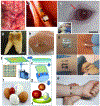The design, fabrication, and applications of flexible biosensing devices
- PMID: 30343162
- PMCID: PMC6310145
- DOI: 10.1016/j.bios.2018.10.019
The design, fabrication, and applications of flexible biosensing devices
Abstract
Flexible biosensors form part of a rapidly growing research field that take advantage of a multidisciplinary approach involving materials, fabrication and design strategies to be able to function at biological interfaces that may be soft, intrinsically curvy, irregular, or elastic. Numerous exciting advancements are being proposed and developed each year towards applications in healthcare, fundamental biomedical research, food safety and environmental monitoring. In order to place these developments in perspective, this review is intended to present an overview on field of flexible biosensor development. We endeavor to show how this subset of the broader field of flexible and wearable devices presents unique characteristics inherent in their design. Initially, a discussion on the structure of flexible biosensors is presented to address the critical issues specific to their design. We then summarize the different materials as substrates that can resist mechanical deformation while retaining their function of the bioreceptors and active elements. Several examples of flexible biosensors are presented based on the different environments in which they may be deployed or on the basis of targeted biological analytes. Challenges and future perspectives pertinent to the current and future stages of development are presented. Through these summaries and discussion, this review is expected to provide insights towards a systematic and fundamental understanding for the fabrication and utilization of flexible biosensors, as well as inspire and improve designs for smart and effective devices in the future.
Keywords: Biosensor; Epidermal sensor; Flexible; Implantable sensor.
Copyright © 2018 Elsevier B.V. All rights reserved.
Figures




Similar articles
-
Wearable Biosensors: An Alternative and Practical Approach in Healthcare and Disease Monitoring.Molecules. 2021 Feb 1;26(3):748. doi: 10.3390/molecules26030748. Molecules. 2021. PMID: 33535493 Free PMC article. Review.
-
Wearable Biosensors in Pediatric Cardiovascular Disease.Circulation. 2019 Jul 30;140(5):350-352. doi: 10.1161/CIRCULATIONAHA.119.038483. Epub 2019 Jul 29. Circulation. 2019. PMID: 31356135 Review. No abstract available.
-
Recent Progress in Wearable Biosensors: From Healthcare Monitoring to Sports Analytics.Biosensors (Basel). 2020 Dec 15;10(12):205. doi: 10.3390/bios10120205. Biosensors (Basel). 2020. PMID: 33333888 Free PMC article. Review.
-
Wearable and Flexible Sensor Devices: Recent Advances in Designs, Fabrication Methods, and Applications.Sensors (Basel). 2025 Feb 24;25(5):1377. doi: 10.3390/s25051377. Sensors (Basel). 2025. PMID: 40096147 Free PMC article. Review.
-
Functionalized Organic Thin Film Transistors for Biosensing.Acc Chem Res. 2019 Feb 19;52(2):277-287. doi: 10.1021/acs.accounts.8b00448. Epub 2019 Jan 8. Acc Chem Res. 2019. PMID: 30620566 Review.
Cited by
-
Low Temperature Adhesive Bonding-Based Fabrication of an Air-Borne Flexible Piezoelectric Micromachined Ultrasonic Transducer.Sensors (Basel). 2020 Jun 11;20(11):3333. doi: 10.3390/s20113333. Sensors (Basel). 2020. PMID: 32545406 Free PMC article.
-
Recent Progress in Organic Electrochemical Transistor-Structured Biosensors.Biosensors (Basel). 2024 Jul 4;14(7):330. doi: 10.3390/bios14070330. Biosensors (Basel). 2024. PMID: 39056606 Free PMC article. Review.
-
Flexible Label-Free Platinum and Bio-PET-Based Immunosensor for the Detection of SARS-CoV-2.Biosensors (Basel). 2023 Jan 26;13(2):190. doi: 10.3390/bios13020190. Biosensors (Basel). 2023. PMID: 36831956 Free PMC article.
-
Electrochemical Biosensors for Pathogen Detection: An Updated Review.Biosensors (Basel). 2022 Oct 26;12(11):927. doi: 10.3390/bios12110927. Biosensors (Basel). 2022. PMID: 36354437 Free PMC article. Review.
-
Molecular Design Strategies toward Improvement of Charge Injection and Ionic Conduction in Organic Mixed Ionic-Electronic Conductors for Organic Electrochemical Transistors.Chem Rev. 2022 Feb 23;122(4):4325-4355. doi: 10.1021/acs.chemrev.1c00266. Epub 2021 Dec 13. Chem Rev. 2022. PMID: 34902244 Free PMC article. Review.
References
-
- Ahani A, Saadati-Fard L, Sodagar AM, Boroumad FA, 2011. Engineering in Medicine and Biology Society, EMBC, 2011 Annual International Conference of the IEEE, pp. 2878–2881. IEEE. - PubMed
-
- Aizenberg J, Fratzl P, 2009. Biological and biomimetic materials. Adv. Mater 21(4), 387–388.
-
- Akşit AC, Onar N, Ebeoglugil MF, Birlik I, Celik E, Ozdemir Ismail, 2009. Electromagnetic and electrical properties of coated cotton fabric with barium ferrite doped polyaniline film. J. Appl. Polym. Sci 113(1), 358–366.
-
- Altman GH, Diaz F, Jakuba C, Calabro T, Horan RL, Chen J, Lu H, Richmond J, Kaplan DL, 2003. Silk-based biomaterials. Biomaterials. 24(3), 401–416. - PubMed
Publication types
MeSH terms
Grants and funding
LinkOut - more resources
Full Text Sources

